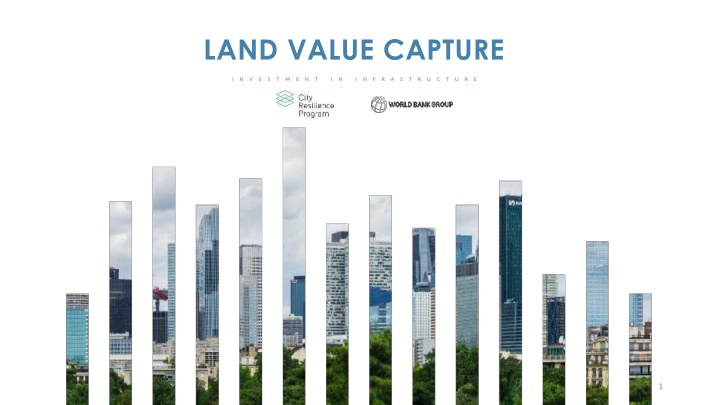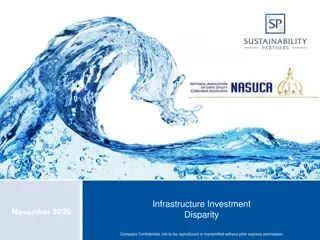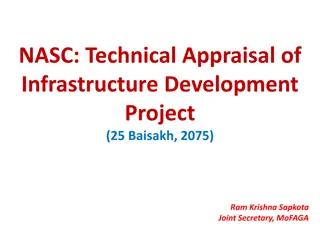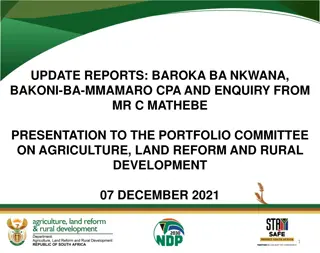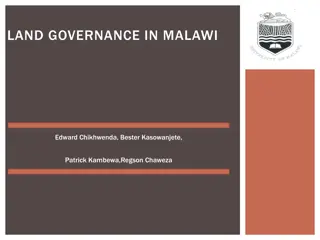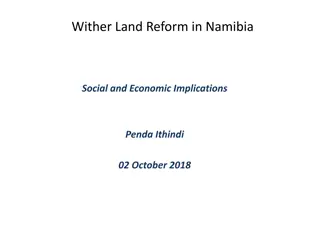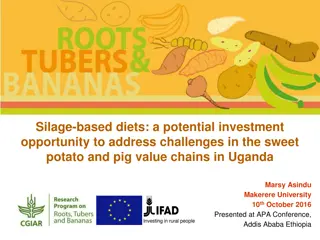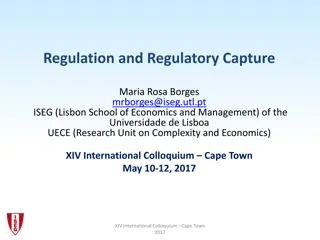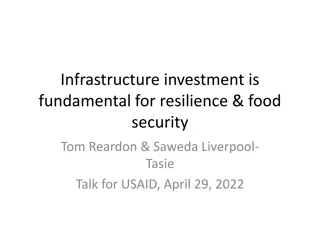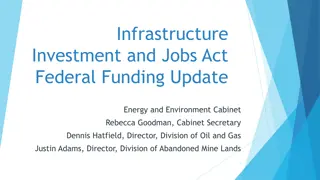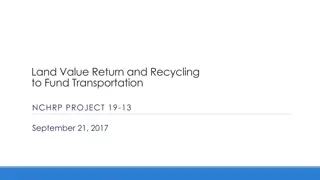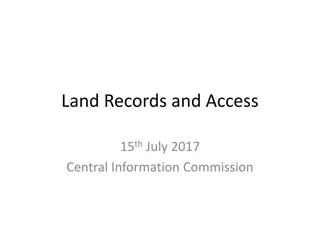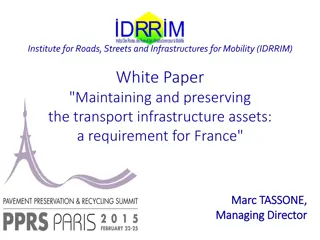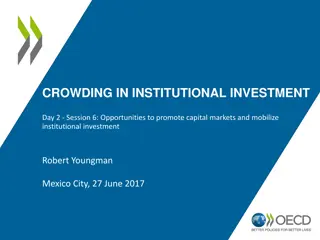Enhancing Infrastructure Investment Through Land Value Capture Mechanisms
Explore the role of Land Value Capture (LVC) in financing urban infrastructure projects, enabling governments to secure upfront funding by capturing real estate value gains. LVC promotes cost-sharing, incentivizes policy measures, and unlocks additional financing in the face of limited traditional sources. Financial resilience and capital market engagement are crucial for meeting the significant investment needs of urban infrastructure, estimated at trillions of dollars annually. Private sector involvement, through modalities like direct lending and concessions, complements public investment efforts, reducing the burden on government balance sheets while creating economic value in urban areas.
Download Presentation

Please find below an Image/Link to download the presentation.
The content on the website is provided AS IS for your information and personal use only. It may not be sold, licensed, or shared on other websites without obtaining consent from the author.If you encounter any issues during the download, it is possible that the publisher has removed the file from their server.
You are allowed to download the files provided on this website for personal or commercial use, subject to the condition that they are used lawfully. All files are the property of their respective owners.
The content on the website is provided AS IS for your information and personal use only. It may not be sold, licensed, or shared on other websites without obtaining consent from the author.
E N D
Presentation Transcript
LAND VALUE CAPTURE I N V E S T M E N T I N I N F R A S T R U C T U R E 1
I N V ES TMEN T I N I N F RAS TRU CTURE THREE PILLARS OF CITY RESILIENCE Governance & Governance & Systems Systems Institutional resilience and reform Infrastructure Infrastructure Physical resilience across sectors Investment needs for cities extend beyond the reach of public finances Finance Finance Projections show that investments of $4.1 to $4.3 trillion in urban infrastructure are needed every year Financial resilience and capital market engagement An incremental 9 to 27 percent ($0.4 trillion to $1.1 trillion) needed to be climate resilient Capital does not flow easily to meet this demand due to lack of knowledge and support from financial services
I N V ES TMEN T I N I N F RAS TRU CTURE PRIVATE SECTOR INVESTMENT IN INFRASTRUCTURE HAS THREE OVERLAPPING MODALITIES Direct lending to a responsible jurisdiction Variety of borrowing mechanisms that can complement each other Full control and financial risk born by public entity Debt Public entity transfers some or most of financing (including but not limited to equity project financing), construction and/or operating responsibilities (and risks) to a private partner Concession Infrastructure financing is part of a broader development effort Reduces impact on government balance sheet Facilitates creation of private economic value in benefiting location Land Value Capture (LVC)
Finance public investment in infrastructure to reduce physical vulnerabilities due to floods, environmental degradation, etc, thereby unlocking land values that are then captured by the city LVC is a LVC is a financial financial policy policy mechanism mechanism that helps that helps governments governments to: to: Secure (or reimburse) upfront infrastructure funding by recouping real estate value gains generated by infrastructure upgrades Levy direct beneficiaries of public improvements, which would otherwise benefit from such improvements as windfall gains Unlock additional funding in conditions of limited access to traditional sources of public sector financing Promote infrastructure cost-sharing with win-win outcomes to public and private stakeholders Incentivize wider policy measures that increase land value, e.g. reduction of local risks
I N V ES TMEN T I N I N F RAS TRU CTURE Example 1: LVC helps the city of Ahmedabad to open up the riverfront Well serviced, walkable waterfront Blighted urban riverfront $17 mln of upfront public investment 30 ha of reclaimed land for sale River access open to public 202 ha of land has been made available for modern development reduce erosion and exposure of the city to flood risk 22km enforced promenade Slums resettlement Sewage upgrade Environmental rehab Land reclamation Place for the poor to build their hutments Inaccessible No new commercial/resid ential development 15% of sale proceeds recovers the cost of entire upfront public investment 7-10 years
I N V ES TMEN T I N I N F RAS TRU CTURE Example 2: LVC helps regenerate Rio de Janeiro s historic area near Bay City earns $1.8 bln from sale of rights to build extra density Underused industrial lands in the historic core of Rio New density and height regulations adopted Regenerated modern mixed- use community Proceeds are directed to hard infrastructure improvements More build-up is facilitated Further sale of development rights City adopted new zoning to allow construction of additional density Structured SPV to sell extra development rights Low-density uses inherited from cargo port Poor accessibility Contaminated waters Unpleasant views The area becomes home to 70,000 new mixed- income residents in a well-serviced, accessible community with nice urban views 3-4 years to sale of a first tranche of development rights, 15 years to fully build out
I N V ES TMEN T I N I N F RAS TRU CTURE LVC establishes a virtuous circle of value from infrastructure upgrades Underserviced Underserviced land land Captured value contributes to recover costs of infrastructure upgrades and/or generates funds for additional infrastructure investment Investments can include hard infrastructure, slum upgrading, environmental remediation Captured value is reinvested in infrastructure Investment in infrastructure upgrade Value captured as a fraction of imputed private developer s profit. Can be captured either upfront or post project completion Can be in monetary terms or as in-kind contribution of proportionate value Part of private developer s profit is captured by the City Improved infrastructure translates into higher desirability and increased development potential of land Upgraded land commands higher values Private developer earns profit from further land improvements Developer s profit is large enough to offset some or entire cost of infrastructure upgrades
I N V ES TMEN T I N I N F RAS TRU CTURE LVC is a new source of project financing promoted by The World Bank If there is a $ 1 billion capital investment program contemplated by a city: Business as usual Business as usual: The World Bank finances $100 million with an interest-bearing term loan Another $900 million is raised from general funds, public/private debt and grants Leveraging LVC: Leveraging LVC: In concert with all of the above, The World Bank provides comprehensive technical assistance to the city to help structure additional funding with re-captured land value (e.g. cash proceeds from sale of land / development rights, special tax assessments, etc.) This works towards overall reduction of the principal of interest-bearing loans, general fund appropriations and grant resources and enhances bankability of the $1 bln program
I N V ES TMEN T I N I N F RAS TRU CTURE Conceptualization of LVC - hypothetical disaggregation of land value Increases in land value due to population growth and economic development. The government, on behalf of the general public, may keep this portion of the land value. Public service providers could capture this portion of the increment to cover the costs of public infrastructure and local service provision. Increases in land value due to public investment in infrastructure and changes in land use regulations. Private land owners should profit from this portion of the increment. Increases in land value due to landowners investments. Land buyers (or lessees) pay sellers (lessors) to obtain the property rights of land. Intrinsic land value
I N V ES TMEN T I N I N F RAS TRUCTURE There is a range of tools used by public sector to capture land value gains Disposition (sale or lease) of excess/underutilized public assets (land, property) for cash that is re-invested in local infrastructure Leveraging public real Leveraging public real assets assets Developer receives development rights (or tenure rights in land, or approval of land use changes) in exchange for obligation to compensate in cash (or provide in-kind) the cost of certain items of public infrastructure benefitting larger area. Development charges Development charges Development rights or certificates of additional density are sold for cash to finance infrastructure improvements Sale of development Sale of development rights rights Land owners or occupants voluntarily contribute part of their land for infrastructure development and for sale to cover some project cost. In return, each land owner receives a serviced plot of smaller area with higher value within the same neighborhood. Land pooling Land pooling /readjustment /readjustment Special assessments/ Special assessments/ betterment levies betterment levies Locally administered tax increments (property taxes, sales taxes, etc.) that generate additional tax revenues for re-investment in local infrastructure Capturing increases in property/land tax base (after infrastructure upgrades) and using such incremental tax proceeds as collateral and refinancing source for infrastructure loans Tax increment Tax increment financing financing
INVESTMENT IN INFRASTRUCTURE LVC mechanisms can be promoted both on privately-owned and public lands, depending on local context Privately-owned land or public land lease* Publicly-owned land Sale/lease of land that underwent public infrastructure upgrades Development changes Sale of development rights Sale/lease of land with development conditions (i.e. negotiated contribution for infrastructure or affordable housing) Land pooling/readjustment Special tax assessments and Tax Increment Financing Land as an equity contribution towards a joint venture * Long term ground lease in this context is considered equivalent to private ownership
INVESTMENT IN INFRASTRUCTURE LVC mechanism allows cost-sharing on initial development stages and that way helps reduce /re-distribute development activation costs Land Value Potential for further Potential for further exponential exponential value growth value growth Development Development- -ready Land (desirable, properly zoned, resilient) ready Land PUBLI PUBLIC CUPGRADES UPGRADES WITH WITH VALUE VALUE CAPTURE CAPTURE OPPORTUNITY OPPORTUNITY Development Enablers: Disaster risk reduction Slum upgrading Hard infrastructure Land consolidation / rezoning Underserved Land Underserved Land (hazard-prone, blight) Developer Barriers: High risk profile Cost-of-carry concerns Free-rider problem Development Timeline
INVESTMENT IN INFRASTRUCTURE LVC may be structured to either increase or to decrease the infrastructure carrying cost of a private project, depending on the project s risk-return profile Infrastructure windfall: public costs for infrastructure are offloaded to private sector; private partner s returns are high enough to absorb extra costs and extended payback Infrastructure bottleneck: upfront infrastructure costs are too high for private sector and are paid by public funds; public costs are later recovered from private partner s operating revenue Cash flow, $ 120 120 80 80 40 40 0 0 -40 -40 -80 -80 -120 -120 1 2 3 4 5 6 7 8 9 10 1 2 3 4 5 6 7 8 9 10 Time periods Cash flow with LVC Cash flow without LVC
INVESTMENT IN INFRASTRUCTURE LVC is an universal policy tool, which could be implemented in various contexts ` Development may face negative mindset due to displacement, NIMBY, redlining, spatial segregation, social stratification, etc. Most effective in burgeoning real estate market Highest land value differential is achieved in areas that are most responsive to infrastructure upgrades (urban core, waterfront, etc.) Public acceptance Inadequate land controls, deficient technology and data systems (e.g. land cadaster) may hinder LVC Legal and regulatory systems Market
INVESTMENT IN INFRASTRUCTURE LVC presets numerous opportunities for local economic development, but may be hindered by local and system-wide constraints LVC builds into the local economic development context by: Bringing positive development implications Bringing positive development implications Being hampered by development challenges Being hampered by development challenges Improved urban environment Lack of real estate market dynamics Self-financed infrastructure Insecure land / property rights Land value gains / Increased tax revenue Regulatory constraints Lack of knowledge / management capacity Enhanced budgetary resources for addressing social goals Corruption
I N V ES TMEN T I N I N F RAS TRU CTURE Despite being largely associated with transportation upgrades, LVC opens financing opportunities for many more infrastructure items Areas with proven track record in LVC Transportation and transit-related assets Water-supply sanitation Sewage and landfill Lack of LVC track record but high LVC potential but high LVC potential Flood mitigation Slum upgrades and resettlement Water-basin / land decontamination Environment cleaning and rehabilitation Historic preservation Land consolidation
I N V ES TMEN T I N I N F RAS TRU CTURE Table below summarizes the common LVC instruments used in practice Instruments Instruments Description Description Examples in developing Examples in developing countries countries Leveraging publicly owned Leveraging publicly owned land / property land / property Disposition of excess public land generates cash for area-wide infrastructure upgrades. Often involve land consolidation (e.g. through eminent domain) or/and entitlement before disposition Bonifacio Global City (Philippines); Sabarmati Riverfront (India) Developer receives development rights in exchange for obligation to compensate in cash (or provide in-kind) the cost of certain items of public infrastructure benefitting larger area. Development Development charges / impact fees / d impact fees / developer exactions / exactions / charges / eveloper Impact fee formula introduced to fund construction of 21-km highway connector between Santiago and northern suburbs In kind/cash developer exactions in cities of Columbia and Chile Sale of development rights Sale of development rights Development rights or certificates of additional density are sold for cash to finance infrastructure improvements CEPAC bonds (Brazil), e.g. Porto Maravilla drainage upgrades; Sale of FSI rights in Mumbai (India) Land pooling Land pooling / readjustment / readjustment Land owners or occupants voluntarily contribute part of their land for infrastructure development and for sale to cover some project cost. In return, each land owner receives a serviced plot of smaller area with higher value within the same neighborhood. About 1/3 of total urban area in Japan and 1/4 of total urban area in South Korea were developed through LP/R. Used in many countries to facilitate peri-urbanization, urban regeneration including slum upgrading, and post-disaster reconstruction. Introduction Introduction of land value of land value taxes taxes Levy on value of underlying land as unimproved (as a substitute or supplement to property tax levied to buildings). Stimulates development to avoid taxation of idling land. Generates property tax and economic activity. Can be effective in areas plagued by disasters Separate taxation of land is introduced in select countries (Taiwan) Land value tax was temporarily introduced in cities of Baja California (Mexico) in early 1990s Betterment Betterment levies / special levies / special assessment assessment Public sector taxes away a portion of land-value gain resulting from publicly funded infrastructure upgrades Riverfront in Pimpri-Chinchwad (India); $2 bln levied during 1997-2015 in Bogota (Columbia) to fund city-wide road/bridge upgrades Tax Increment Financing Tax Increment Financing (TIF) (TIF) TIF aims to capture and leverage estimated future revenues from incremental increases in collection of property (or other) taxes within a geographically specified area of redevelopment, a TIF district Colombia and South Africa are currently piloting TIF. Proxy TIF in Greater Hyderabad (India) where conventional loans were originated to fund infrastructure projects and set to be refinanced with property tax gains
I N V ES TMEN T I N I N F RAS TRU CTURE A wealth of value capture techniques established in practice, can be classified based on the nature and timing of value-capturing charges Tax-based vs. Fee-based vs. Incentive-based Tax Tax- -based based: betterment levies, special assessment, TIF, land value tax Fee Fee- -based based: exactions, sale/lease of public land, sale of development rights Incentive Incentive- -based: based: land pooling/readjustment, density bonus, negotiated land sale/lease with development conditions, joint development with public land as equity Value capture timing (one-time vs. recurring; upfront vs. upon completion) One One- -time charges time charges: exactions, sale of development rights, betterment levies, public land sale, land pooling/readjustment (upfront land contribution) Recurring charges Recurring charges: TIF, land value tax, special assessment Either Either- -or or: public land lease
I N V ES TMEN T I N I N F RAS TRU CTURE Relevance of LVC tools may vary depending on the implementation conditions of each context (table below only indicative) Unestablished land market Lack of land use controls and regulations Deficient land Cadaster / records Insecure property rights Limited access to capital markets Non-devolved fiscal powers Impact fees / Exactions Betterment levies Leveraging public assets Land pooling / readjustment Sale of development rights Land value tax Tax Increment Financing Prohibitive challenge (regulatory / systemwide changes are prerequisite) Limited systemwide arrangements needed. Respective implementation terms can be set at deal level Significant challenge (regulatory/legislative changes required in certain conditions)
SELECTED LAND VALUE CAPTURE INSTRUMENTS APPENDIX APPENDIX Negotiated Exactions Impact Fees Leveraging Public Assets Sale of Development Rights Land Pooling/Readjustment Land Value Tax Betterment Levies Tax Increment Financing
I N V ES TMEN T I N I N F RAS TRU CTURE Negotiated Exaction: Overview DESCRIPTION In-kind (land, improvement) or cash contribution by a developer to foster infrastructure upgrades related to a proposed real estate project (to that end, Exactions are similar in principle to Impact Fees). It typically works as a payment for building exemptions (higher land use, density, or eased construction norms) or other forms of development-enabling certifications. In contrast to Impact Fees (that are applied systemwide on a formula basis), Exactions are typically applied case by case through a vis-a-vis negotiated transaction. KEY REQUIREMENTS / IMPLEMENTATION FACTORS Clear land use and town-planning regulations and rigid construction norms (for setting baseline conditions). Local government s capacity in planning and implementation (to be able to fulfill infrastructure obligations). Rigid public outreach approach to explain what standard building/land use regulations are traded for.
I N V ES TMEN T I N I N F RAS TRU CTURE Negotiated Exaction: Lessons Learned CHALLENGES OPPORTUNITIES As long as exactions are negotiated on case by case, entry barriers to development projects are less predictable Straightforward two-way transaction Minimal fiscal impact Minimum framework regulatory arrangements needed. Transaction can be fully structured with ad hoc deal terms Regulatory exemptions traded for development permits may fail to generate enough public good outside of a project itself. Infrastructure upgrades and related development with eased regulations shall generate wider public benefit and justify diversion from standard regulations In view of the above, objection from the public to exaction-driven private development is common
I N V ES TMEN T I N I N F RAS TRU CTURE Negotiated Exaction: Sample Project Western super-collector, Casablanca, Morocco The project equips the city of Casablanca with a 9-km long collector to drain and canalize floodwater of Oued Bouskoura river and discharge directly into the ocean. Project Description Project Description The collector will reduce exposure of large parts of Greater Casablanca to flooding and will increase the city s flood protection to a 20-year level. $90 million, 95% complete as of March 2017. Funding sources include PPP to include government (40%) and municipal funds (30%), National Fund to Combat Natural Disasters, and private funds A fraction of the project was financed with contributions from private companies owning and developing real estate in the flood-affected areas of Oued Bouskoura basin. Value Capture Value Capture Component Component Such contributions included $8 million from the Morocco s largest private company, OCP Group (phosphate producer), which develops industrial facilities and a leisure center in the Bouskoura basin.
I N V ES TMEN T I N I N F RAS TRU CTURE Impact Fees: Overview DESCRIPTION Developers are assessed an extra cash charge to compensate the cost of area-wide infrastructure upgrades. Per standard scheme, it is a one-time charge applied routinely by a local jurisdiction to real estate development projects contemplated in the area impacted by infrastructure upgrades. The proceeds from the charge finance (or refinance) a portion of the cost of facilities upgrades. Such charge is assessed on a formula that considers benefit allocation, intensity of land use, distance to the upgraded infrastructure etc. KEY REQUIREMENTS / IMPLEMENTATION FACTORS Strong planning and analytical capacity at local level needed for planning and costing infrastructure upgrades, along with devising a solid approach in allocation of benefits across different locations / projects. Strong execution of public investment plans. Transparent and stringent formula for impact fee calculation (allowing developers to credibly project impact fees in development financial pro forms).
I N V ES TMEN T I N I N F RAS TRU CTURE Impact Fees: Lessons Learned CHALLENGES OPPORTUNITIES Extra charges may hinder development activity. Relatively straightforward two-way transaction If applied improperly may become a disincentive to develop land to its highest and best use Minimal negative fiscal impact (e.g. municipal cash flow is not ring-fenced in any way) Infrastructure benefits are distributed unevenly. Imperfections in apportioning off-site costs are inevitable Efficient tool to redistribute costs of development-enabling infrastructure (avoids overburdening of first-comers and free-riding of followers) Works best for hard and basic infrastructure that has direct and quantifiable impact (such as transit or sewer/water upgrades). Less prudent for infrastructure items where short-term impacts are less tangible (e.g. resilience enhancement, green infrastructure).
I N V ES TMEN T I N I N F RAS TRU CTURE Impact Fees: Sampled Project New highway to connect sprawled development with urban core, Santiago, Chile In late 1990s Santiago metropolitan region started expanding north in the Chacabuco province with 14 major real estate projects approved (primarily housing), adding 40,000 new households to the metro region. Project Description Project Description The new housing projects were to be built on agricultural land lacking urban infrastructure services. Most notably the new urban districts were lacking connectivity to Santiago s urban core. To address that, a 21-km radial highway connecting to central Santiago was to be built with additional 41-km of byways and interchanges. The total cost of new road network development was estimated at US$106 million. National government took the upper hand in planning, organizing a builder concession and structuring funding that comprised 39% government funding and 61% coming from developer impact fees. Value Capture Value Capture Component Component The impact fee formula implied a cash charge levied per buildable housing unit. The fee varied based on each project s formalized impact on regional road network: location relative to new road, project size, and estimated travel demands. The impact fee averaged about US $1,600 per housing unit.
I N V ES TMEN T I N I N F RAS TRU CTURE Leveraging Public Assets: Overview DESCRIPTION Disposition of publicly-owned assets (land, buildings) to a private developer whereby value is realized either directly (e.g. sale proceeds) or through creation of future development value or socioeconomic benefit Depending on market conditions and a specific deal structure such disposition may come through direct arm s length sale, auctioning, lease, or conveyance/below-market sale as a form of in-kind contribution to developer equity or for infrastructure or amenity provision The asset may be disposed either in as is condition (if it immanently represents tangible value to the private-sector partner) or following some initial investment by government KEY REQUIREMENTS / IMPLEMENTATION FACTORS Availability of excess/underutilized public assets either per se or through asset consolidation / optimization Market value of the public assets can be clearly established and have potential to generate additional value Government must communicate effectively to citizens its rationale for disposing public assets Public entity must have negotiating capacity on par with private sector developers to achieve fair pricing
I N V ES TMEN T I N I N F RAS TRU CTURE Leveraging Public Assets: Lessons Learned CHALLENGES OPPORTUNITIES Sizing and timing market demand requires special knowledge that municipality may not posses Can result in direct cash revenue for a municipality Puts a vacant or underutilized asset back into productive use Regulatory /legislative limitations on public asset disposition may stall or encumber the process Allows quick value recycling (in certain conditions enables a city to invest in infrastructure upgrades upfront without tapping general revenue funds) Sale of municipality-owned land may result in loss of control over future development (especially when city-level land use controls are not robust) Minimal negative fiscal impact Negotiated disposition price of publicly-owned assets may face public objection and raise political concerns Relatively straightforward two-way transaction (once value to private sector partners is established and price of property negotiated)
I N V ES TMEN T I N I N F RAS TRU CTURE Leveraging Public Assests: Sampled Project 1 Sabarmati Riverfront Upgrade, Ahmedabad, India Aims to provide the city of Ahmedabad with an improved and accessible waterfront along the Sabarmati River, reduce erosion and exposure of the city to flood risk, upgrade sewers, and rehabilitate and resettle slums Project Description Project Description $17 million spent on all heavy engineering works and land reclamation as well as on 22 km lower river promenade complete, upper promenade still in development. Key financing sources are loans from a local municipal corporation and a central government financial institution SPV established to manage initial investment in riverfront upgrade and subsequent land sales to the private sector. The project is self-financed cash for recovery of capital expenditure and operating costs comes from sales of reclaimed and serviced land for commercial development Value Capture Value Capture Component Component Completion of major infrastructural components have already led to increased land values, thus reducing the amount of land that needs to be transacted for servicing the loans. Overall the amount invested has been recovered from sales of less than 15% of improved land.
I N V ES TMEN T I N I N F RAS TRU CTURE Leveraging Public Assets: Sampled Project 2 Bonifacio Global City Drainage, Manila, Philippines Bonifacio Global City Drainage, Manila, Philippines An underground drainage detention structure serving as a flood control facility for Bonifacio Global City Project Description Project Description Core element of an elaborate drainage system that collects rainwater from paved urban surfaces then releases it under controlled conditions Construction was financed by proceeds from the $800 million land sale following packaging of public/private interests into a development joint venture Funding infrastructure improvements with land sale proceeds post entitlement of undeveloped military lands to real estate development area Value Capture Value Capture Component Component
I N V ES TMEN T I N I N F RAS TRU CTURE Sale of Development Rights: Overview DESCRIPTION DESCRIPTION Generates funding for public infrastructure by selling development rights instead of rights in land (rights in land may either be already obtained, or not intended for transfer or simply come with development rights) Sellable development rights fall into two categories: the right to convert less productive (lower) use to a higher use, and the right to build at greater densities than normally would be allowed by existing zoning Sale of development rights can be organized through sale of development certificates that act as financial market derivatives (bonds) transferrable in the stock market and thus able to increase liquidity and cash generating potential of this instrument (such as CEPAC bonds in Brazil) KEY REQUIREMENTS / IMPLEMENTATION FACTORS KEY REQUIREMENTS / IMPLEMENTATION FACTORS Larger urban areas with strong real estate markets maintaining enough demand and growth potential for high-density development Relatively deep capital markets for realization of schemes similar to CEPACs Rigid land use controls, property records (cadaster) and property appraisal systems have to be in place
I N V ES TMEN T I N I N F RAS TRU CTURE Sale of Development Rights: Lessons Learned CHALLENGES OPPORTUNITIES Restricted applicability, i.e. may not work in the secondary markets where demand for higher density development is not strong enough Direct revenue source that may generate cash for front-funding or expedited cost recovery of infrastructure projects i.e. positive fiscal impact Vulnerable to macroeconomic conditions (more than many other LVC tools) More liquid revenue source than sale of land rights For efficient and equitable implementation, strong and transparent land use controls are prerequisite Sale of development rights better mitigates the risks of loss of control over land use (relative to selling land title alone)
I N V ES TMEN T I N I N F RAS TRU CTURE Sale of Development Rights: Sampled Project Porto Maravilha Urban Waterfront Revitalization, Rio de Janeiro, Brazil Revitalization of underutilized Guanabara Bay waterfront (mostly government-owned port and near-port lands) into a brand new mixed-use, mixed-income community. The main rationale is the regeneration of this heavily underserviced area in the heart of Latin America s major metropolis, by intensifying and blending new uses Project Description The development plan includes complete reconstruction of local water, sanitation, and drainage systems, extensive streetscaping and landscaping, installation of three brand new sanitation plants, historic preservation, social inclusion (at least 3,000 social housing units are being delivered), and cultural and education initiatives The area comprises 1,250 acres and is home to 35,000 residents (subject to increase to 100,000 post regeneration). The program commenced in 2009, with full recycling of approved additional density anticipated by 2025. Project-underlying infrastructure has primarily been financed through CEPACs, following adoption of a new law to substantially increase density and height limitations set in the Porto Maravilha area. Value Capture Component More than 4 million sq m of additional density was sold via CEPACs during 2011-2013 generating US$1.8 billion in upfront infrastructure funding (the initial purchaser of a CEPACs was a state-owned financial bank CEF, which passes CEPACs through, selling them at a profit, to private real estate developers as demand arises)
I N V ES TMEN T I N I N F RAS TRU CTURE Land Pooling / Land Readjustment: Overview DESCRIPTION DESCRIPTION A participatory process in which land owners (or occupants) voluntarily contribute a certain percentage of their land for infrastructure development and for sale to cover part of project cost. In return, each land owner receives a serviced plot of smaller area but with higher value within the same neighborhood LP/R provides an alternative to expropriation, with minimal displacement Many countries used LP/R to facilitate peri-urbanization, urban regeneration including slum upgrading, and post-disaster and post-conflict reconstruction KEY REQUIREMENTS / IMPLEMENTATION FACTORS KEY REQUIREMENTS / IMPLEMENTATION FACTORS Generally requires consent of supermajority of land owners to approve the project Appropriate legal framework that empowers local authority to legally take land from dissenting landowners when supermajority agrees More feasible in areas with high land value increase potential after project completes Shall be guided by a city s mater plan Quality of property records and cadaster map is important to expedite implementation
I N V ES TMEN T I N I N F RAS TRU CTURE Land Pooling / Land Readjustment: Lessons Learned CHALLENGES OPPORTUNITIES Land owners consensus can be difficult to obtain especially if projects fully rely on their voluntary participation Assembles land for urban expansion and revitalization with minimal displacement. Helps recover a portion of the project cost. Requires strong project management and technical capacity, particularly in negotiation and building consensus with land owners Promotes intensification of land use, thereby enhancing land value for landowners and expanding the property tax base for the municipality. Not all projects can achieve self-financing and may require public funding to cover part of project cost Distributes land redevelopment costs and benefits equitably among landowners and other stakeholders such as the municipality, private developers, and the community, especially the urban poor and landless. Encourages public participation in policy decision-making.
I N V ES TMEN T I N I N F RAS TRU CTURE Land Pooling / Land Readjustment : Sampled Project Land Pooling/Readjustment Pilot, Tra Vinh, Vietnam With technical assistance from the World Bank, Tra Vinh city in Vietnam is currently piloting land pooling/readjustment approach to redeveloping a centrally located low income neighborhood, in order to address issues of flooding and lack of drainage network and access roads. The city has very limited budget, and LP/R becomes the only viable approach as development cost is shared between the city and local residents. Project Description The neighborhood has an area of about 24 hectares, including about 1000 land plots that belong to 480 land users (under Vietnam s public leasehold system). A sub-area of 4 hectares was selected as the pilot site. Site plan ensures access to every land parcel yet avoid demolition of existing structures to the extent possible. Over 90% of the land users in the pilot area have agreed to participate in the project so far. With World Bank support, a new decree that includes LP/R provisions was approved in January 2017, which became the first legal framework for LP/R in Vietnam. As this is the first pilot project, the city plans to cover about 70% of the total investment cost from its budget in order to reduce land contribution from the land users and gain support from the community. The remaining 30% of the total cost will be covered by sale of surplus land. Value Capture Component For agriculture land, each land user will contribute 33% of their land area into the project, and for residential land each land user will contribute 13%. Preliminary land value assessment shows that land price on average is estimated to increase by 3.5 to 5 times after the pilot project. The city expects that future revenue from land in the project area, such as land transaction tax, land use conversion fee (from agricultural to residential), and land tax, will also increase substantially as a result of the pilot project.
I N V ES TMEN T I N I N F RAS TRU CTURE Land Value Tax: Overview DESCRIPTION Tax instrument that assesses value of land as unimproved , opposite to conventional property tax that focuses on taxing factual value of land with improvements. Aims to differentiate tax burden to land owners based on windfall benefits of unimproved land location, physical characteristics and neighboring uses Directed at incentivizing improvement of underused urban sites by making land idling and holding prime lands for speculation a burdensome option for landowners KEY REQUIREMENTS / IMPLEMENTATION FACTORS Robust land cadaster, land assessment and regular re-assessment practice Effective tax administration capacity at the local level Strong local real estate market that naturally differentiates values of land in unimproved condition based purely on location quality and preeminent development potential Fiscal decentralization
I N V ES TMEN T I N I N F RAS TRU CTURE Land Value Tax: Lessons Learned CHALLENGES OPPORTUNITIES Might increase complexities of tax administration Incentivizes development of unimproved/underutilized land in prime urban locations Needs technical capacity at municipal level for maintaining advanced land cadaster and land reassessment systems Can leverage property tax assessment systems already in place Fiscal powers have to be devolved so that municipalities could structure and impose such a tax Can be an effective tool to spur revitalization in areas affected by natural hazards If adequately structured and implemented can increase tax revenue providing additional funds for public works
I N V ES TMEN T I N I N F RAS TRU CTURE Land Value Tax: Sampled Project Introduction of Land Value Tax in the City of Mexicali, Mexico Introduction of Land Value Tax in the City of Mexicali, Mexico In 1989 the city of Mexicali diverted from conventional practice assessing a composite property tax on both land and permanent structures and started taxing only the value of the land Project Description Project Description This fiscal policy shift involved major changes in tax administration including changes in land assessment promoted by consensus of representatives from real estate organizations and professional appraisal associations New tax rates were specified based on distance from pre-specified high-value locations . Separate flat-rate surcharges were applied to residential and commercial lands. This new tax policy waned out after changes in Mexicali s municipal administration and the land value tax was eventually terminated in the City of Mexicali. However, the positive results in the first years of land taxing in Mexicali prompted other municipalities of the state of Baja California to implement land value taxing in their jurisdictions Value Capture Value Capture Component Component During the first periods of implementation the new taxing system allowed the Citi of Mexicali to increase property tax revenue twofold generating additional revenue for infrastructure upgrades
I N V ES TMEN T I N I N F RAS TRU CTURE Betterment Levies: Overview DESCRIPTION An additional tax/special rate levied to property owners within a specifically defined geographic area, which is regarded as the main concentration of beneficiaries of respective publicly funded infrastructure upgrades Betterment levies are also called special assessments in some countries Application of betterment levy can be narrowed down to specific types of users or owners within the defined geographic area, such as owners of large commercial building or owners who have an intent to develop in the area and are seeking construction permit Rate and length of time of the levy depends on when and how funding requirement is fulfilled In contrast to Tax Increment Financing (TIF), betterment levy is applied to full assessed value, whereas in TIF a special assessment applies to incremental property value increase. KEY REQUIREMENTS / IMPLEMENTATION FACTORS Systemwide fiscal regulations should allow special tax assessment and collection at municipal level Robust property appraisal and land cadaster systems
I N V ES TMEN T I N I N F RAS TRU CTURE Betterment Levies: Lessons Learned CHALLENGES OPPORTUNITIES Can be a legally complex and time-consuming arrangement Generally allows to raise money off balance sheet without increasing city-wide property taxes Requires adoption of special fiscal regulations that are out of control of municipality Tends to align costs of public improvements with those who will benefit the most from such improvements Administration of such tax may be costly Delineation of special assessment area often follows jurisdictional borders which causes imperfection in allocation of cost to actual beneficiaries Recurrent and reliable source of municipal revenue Less complex than TIF as another tax-based LVC Cost effective alternative to municipal borrowing with no negative fiscal impact
I N V ES TMEN T I N I N F RAS TRU CTURE Betterment Levies: Sampled Project Riverfront Development, Pune, India Local Municipal Corporation is considering complex improvements on the banks of three rivers flowing through the municipality (building embankments for flood protection, sewage treatment, desilting, landscaping, and enhancing connectivity between the banks) Project Description $18 million, concept stage master planning works started in 2016 Upfront costs to be covered by government and the municipal corporation Recovery of municipal costs through charging flood premiums on top of construction permitting fees Value Capture Component Changes in town-planning codes proposed to allow development in the 25-year flood zones on condition of recovering a flood premium from developers Flood premium is calculated as 25% of assessed value ( ready reckoner rate ) of land or real property in a respective geographic area of the city Such flood premium to be administered by the Municipal Corporation and has to be utilized for riverfront development
I N V ES TMEN T I N I N F RAS TRU CTURE Tax Increment Financing (TIF): Overview DESCRIPTION TIF provides an alternative to finance urban infrastructure in blighted and underdeveloped areas, unlocking (private) development that wouldn t otherwise occur in the absence of those up-front investments TIF aims to capture and leverage estimated future revenues from incremental increases in collection of property (or other) taxes within a geographically specified area of redevelopment, a TIF district . Local governments use a debt instrument (bonds or loans) backed by the projected future tax revenue within the TIF district. The debt instrument proceeds to pay for up-front investments such as land acquisition, upgrade of water system, road improvements, or remediation of environmental contamination. Up-front investments create the real estate market and economic conditions that lead to the incremental increase in land value and tax revenue, which closes a virtuous cycle in which growth pays for growth KEY REQUIREMENTS / IMPLEMENTATION FACTORS Robust land cadaster, land assessment and tax administration capacity at the local level Strong political backing to enabling legislation Might require credit enhancement (e.g guarantees) from the city or the nation Strong real estate markets maintaining enough demand and growth potential for high-density development Relatively deep capital markets
I N V ES TMEN T I N I N F RAS TRU CTURE Tax Increment Financing (TIF): Lessons Learned CHALLENGES OPPORTUNITIES Not all cities, not at all times: it requires a robust real estate market It complements the traditional financing instruments Requires a strong cadastre and tax collection system If properly structured, TIF debt does not affect the balance of the city It absorbs and restricts the use of future revenues (the delta generated by development) Maximizes private investment since it uses financial structuring TIF allows for greater private economic investment without requiring infrastructure investment by the city official books It is vulnerable to national and local economic crises, which creates repayment risks It requires a strong commitment of the city beyond political cycles to ensue continuity of economic development and TIF legislation between administrations Strengthens municipal management as it requires high coordination between entities Promotes the depth of capital markets in municipal financing
I N V ES TMEN T I N I N F RAS TRU CTURE Tax Increment Financing (TIF): Sampled Project Creating the first TIF in Latin America in Medellin, Colombia Since 2011 the World Bank has provided technical advice to the Government of Colombia to support cities to structure & take to market innovative land-based financial instruments that would leverage private finance for urban infrastructure. Project Description The initiative thus far has focused on ascertaining the legal and financial feasibility of implementing a TIF operation of a major urban renovation project in Medellin called the Innovation District The proposed urban development plan includes redevelopment of 184 hectares comprising four neighborhoods in downtown Medellin, targeting to develop 1.6m m2 over a 12 year period, including 60,000 m2 of social housing Legal feasibility analysis showed that Colombian legislation indirectly limits the use of incremental revenues by restricting local administrations to securitize future revenues beyond their government periods (four years). With the support of the Bank, the City of Medellin is currently in the process of developing the overall regulatory framework to legally enable the use of TIF at the city level Value Capture Component Preliminary results showed that the Innovation District would potentially benefit from use of TIF to fund catalytic public infrastructure If the project meets expectations (1.6 million m2), cash-flow analyses showed that the project has the potential to increase tax revenue from the area by over 400% in peak years, which could potentially collect about US$45m in revenue bonds, which would enable the city to fund 25% of projected up-front infrastructure requirements.
THANK YOU 46
